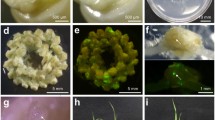Summary
The ability to recover male gametophyte derived plants, which is necessary to get transformed haploid plants, was verified for a hybrid of maize. Using the isolated microspore culture technique, a 9 × 10−5 plant regeneration frequency was obtained. Maize microspores were bombarded with tungsten particles using a PDS He/1000 apparatus. GUS expression in the microspores was maximum with 1.1 μm diameter tungsten microprojectiles for 1100 and 1350 psi helium pressures at a 6 cm distance between the launch point and the target cells. Increasing the amount of DNA coated on the microparticles from 1.66 to 4 μg DNA/mg of particles allowed a two-fold and four-fold increase of the GUS-expressing microspore frequency for 1100 and 1350 psi helium pressure bombardment, respectively. Optimal concentration of solidifying agent in the bombardment support culture medium was found to be 1%. Cell density ranging from 25000 microspores/bombardment to 100000 microspores/bombardment did not affect the frequency of GUS-expressing microspores. Using these optimal conditions, the maximum frequency of GUS-expressing microspores was found to be about 9 × 10−4, while maintaining an embryo formation frequency about 5 × 10−4.
Similar content being viewed by others
Abbreviations
- GUS:
-
β-glucuronidase
- PEG:
-
polyethylene glycol
References
Abdul-Baki AA, Saunders JA, Matthews BF, Pittarelli GW (1990) DNA uptake during electroporation of germinating pollen grains. Plant Sci 70: 181–190
Beckert M (1994) Advantages and disadvantages of the use of in vitro/in situ produced DH maize plants. In: Bajaj YPS (ed) Biotechnology in agriculture and forestry, vol 25, maize. Springer, Berlin Heidelberg New York Tokyo, pp 201–212
Bolik M, Koop HU (1991) Identification of embryogenic microspores of barley by individual selection and culture and their potential for transformation by microinjection. Protoplasma 162: 61–68
Coumans MP, Sohota S, Swanson EB (1989) Plant development from isolated microspores ofZea mays L. Plant Cell Rep 7: 618–621
Fennell A, Hauptmann R (1992) Electroporation and PEG delivery of DNA into maize microspores. Plant Cell Rep 11: 567–570
Gaillard A, Matthys-Rochon E, Dumas C (1992) Selection of microspore derived embryogenic structures in maize related to transformation potential by microinjection. Bot Act 105: 313–318
—, Vergne P, Beckert M (1991) Optimization of maize microspore isolation and culture conditions for reliable plant regeneration. Plant Cell Rep 10: 55–58
Hamilton DA, Roy M, Rueda J, Sindhu RK, Sanford J, Mascarenhas JP (1992) Dissection of a pollen-specific promoter from maize by transient transformation assays. Plant Mol Biol 18: 211–218
Jahne A, Becker D, Lörz H (1994) Genetic engineering of cereal crop plants. In: Jones PW, Casselles AC (eds) Proceedings EUCARPIA, the methodologies in plant genetic manipulation: criteria for decision making, Cork, September 1994, pp 38–39
Jefferson RA, Wilson KJ (1991) The GUS gene fusion system. Plant Mol Biol System B 14: 1–33
Klein TM, Gradzieil T, Fromm ME, Sanford JC (1988) Genetic transformation of maize cells by particle bombardment. Plant Physiol 91: 440–444
Kuhlmann U, Foroughi-Wehr B, Graner A, Wenzel G (1991) Improved culture system for microspores of barley to become a target for DNA uptake. Plant Breed 107: 165–168
McElroy D. Blowers AD, Jenes B, Wu R (1991) Construction of expression vectors based on the rice actin 1 (Actl) 5′ region for use in monocot transformation. Mol Gen Genet 231: 150–160
Nishihara M, Ito M, Tanaka I, Kyo M, Ono K, Irifune K, Morikawa H (1993) Expression of the β-glucuronidase gene in pollen of lily (Lilium longiflorum), tobacco(Nicotiana tabacum), Nicotiana rustica, and peony (Paeonia lactiflora) by particle bombardment. Plant Physiol 102: 357–361
Pechan PM (1989) Successful cocultivation ofBrassica napus microspores and proembryos withAgrobacterium. Plant Cell Rep 8: 387–390
Pretova A, de Ruijter NCA, van Lammeren AAM, Schel JHN (1993) Structural observation during androgenic microspore culture of 4 cl genotype ofZea mays L. Euphytica 65: 61–69
Sanford JC (1990) Biolistic plant transformation. Physiol Plant 79: 206–209
—, Smith FD, Russell JA (1993) Optimizing the biolistic process for different biological applications. Methods Enzymol 217: 483–509
Stöger E, Benito Moreno RM, Ylstra B, Vicente O, Heberle-Bors E (1992) Comparison of different techniques for gene transfer into mature and immature tobacco pollen. Transgen Res 1: 71–78
Twell D, Klein TM, Fromm ME, McCormick S (1989) Transient expression of chimeric genes delivered into pollen by microprojectile bombardment. Plant Physiol 91: 1270–1274
van der Leede-Plegt LM, van de Ven BCE, Bino RJ, van der Salm TPM, van Tunen AJ (1992) Introduction and differential use of various promoters in pollen grains ofNicotiana glutinosa andLilium longiflorum. Plant Cell Rep 11: 20–24
Author information
Authors and Affiliations
Rights and permissions
About this article
Cite this article
Jardinaud, M.F., Souvré, A., Alibert, G. et al. uidA gene transfer and expression in maize microspores using the biolistic method. Protoplasma 187, 138–143 (1995). https://doi.org/10.1007/BF01280242
Received:
Accepted:
Issue Date:
DOI: https://doi.org/10.1007/BF01280242




